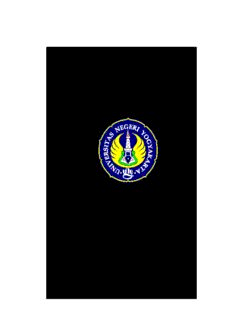
i USING STORY-MAPPING TECHNIQUE TO IMPROVE THE WRITING ABILITY OF GRADE VIII ... PDF
Preview i USING STORY-MAPPING TECHNIQUE TO IMPROVE THE WRITING ABILITY OF GRADE VIII ...
USING STORY-MAPPING TECHNIQUE TO IMPROVE THE WRITING ABILITY OF GRADE VIII STUDENTS AT SMP N 2 GAMPING, SLEMAN IN THE ACADEMIC YEAR OF 2013/2014 A THESIS Presented as Partial Fulfilment of the Requirements for the Attainment of the Sarjana Pendidikan Degree in English Language Education By: Teddy Ansyah Abidin 09202241050 ENGLISH EDUCATION DEPARTMENT FACULTY OF LANGUAGES AND ARTS YOGYAKARTA STATE UNIVERSITY 2014 i ii iii PERNYATAAN Yang bertanda tangan di bawah ini, Saya: Nama : Teddy Ansyah Abidin NIM : 09202241050 Prodi : Pendidikan Bahasa Inggris Fakultas : B ahasa dan Seni Judul Skripsi : Using Story-Mapping Technique to Improve the Writing Ability of Grade VIII Students at SMP N 2 Gamping, Sleman in the Academic Year of 2013/2014 menyatakan bahwa karya ilmiah ini adalah hasil pekerjaan saya sendiri. Sepanjang pengetahuan saya, karya ilmiah ini tidak berisi materi yang ditulis oleh orang lain kecuali bagian-bagian tertentu yang saya ambil sebagai acuan dengan mengikuti tata cara dan etika penulisan karya ilmiah yang lazim. Apabila ternyata terbukti bahwa pernyataan ini tidak benar, sepenuhnya menjadi tanggung jawab saya. Yogyakarta, April 2014 Penulis Teddy Ansyah Abidin NIM 09202241050 iv DEDICATIONS Purwanto and Mujiasih Loving parents and inspiring teachers Hasan Musthofa Beloved brother v MOTTOS “Verily, with every difficulty there is relief”. (Qs. Al Insyiroh 94:6) Narated By Abu Hurairah : “The Apostle of Allah (pbuh) said: If anyone pursues a path in knowledge, Allah will thereby make easy for him a path to the Paradise; and he who is made slow by his actions will not be speeded by his genealogy”. (Shahih: Muslim) vi ACKNOWLEDGEMENTS Alhamdulillahhirobilalamin, all praise be to Allah SWT who has blessed me with the best things in my life. His blessing has empowered me to finish this thesis. Peace be upon Muhammad SAW, the last messenger of the only greatest teaching. I would like to express my gratitude to my first supervisor, Dr. Margana, M.Hum.,M.A. and my second supervisor Dwiyani Pratiwi, S.Pd., M.Hum. who have guided me during the process of the thesis writing. I thank them for all their advice, directions, understanding, and encouragements. I also thank the Principal of SMP N 2 Gamping, Sugiyarto, S.pd. for giving me permission to conduct the research in the school and the English teacher, Sri Nurfuaddiyah, S.Pd. for her cooperation and help during the research. Great thanks are also given to the students of grade eight for being cooperative to be my correspondents. I would like to express my appreciation to my family. First, I would like to thank my beloved father and mother, Purwanto and Mujiasih who never stop praying for me and inspire me to do the best. Second, I would like to thank Hasan Musthofa, my beloved brother. Third, I would like to thank my collaborator, Asfar Arif, who always accompanied and helped me during the research. I would also like to thank to my friends in English Language Education Department, especially my friends in PBI C’09 Class (Lisma, Ketik, Desi, Reren, Nisa, Nana, Winda, Hani, Gebi, Murni, Festri, Doni, Yongki, and Isa), thank you for the discussion, the help, and for the nice friendship. Last but not least, I would express my thanks to my friends in UKM Karate ‘INKAI’ UNY, EDULT Football Club, GK III/920 Family, and SALC UNY who always cheer me up in every situation. vii Finally, I hope that this thesis will be useful for the readers. However, I realize that this thesis is far from being perfect. Therefore, any criticisms, ideas, and suggestions for the improvement of this thesis are greatly appreciated. Yogyakarta, 28 April 2014 Teddy Ansyah Abidin viii TABLE OF CONTENTS TITLE ........................................................................................................... i APPROVAL PAGE ..................................................................................... ii RATIFICATION .......................................................................................... iii HALAMAN PERNYATAAN ......................................................................... iv DEDICATION ............................................................................................... v MOTTO ........................................................................................................ vi ACKNOWLEDGMENTS ........................................................................... vii TABLE OF CONTENTS ............................................................................. ix LIST OF TABLES ........................................................................................ xii LIST OF FIGURES ...................................................................................... xiii LIST OF APPENDICES .............................................................................. xiv ABSTRACT .................................................................................................. xv CHAPTER I INTRODUCTION A. Background of the Research ..................................................... 1 B. The Identification of the Problem ............................................. 3 C. The Limitation of the Problem .................................................. 4 D. The Formulation of the Problem ............................................... 5 E. The Objectives of the Research................................................. 6 F. The Significances of the Research ........................................... 6 CHAPTER II LITERATURE REVIEW AND CONCEPTUAL FRAMEWORK A. Literature Review ...................................................................... 8 1. Theory of Writing ............................................................... 8 a. What is Writing ........................................................... 8 b. Micro Skills and macro skills of Writing .................... 10 c. Writing Process ........................................................... 12 d. The Characteristic of Good Writing ............................ 15 ix e. The Components of Writing ....................................... 16 f. Short Story Writing ..................................................... 17 g. Teaching Writing ........................................................ 19 h. Teaching Writing in Junior High School .................... 21 2. The Story-mapping Technique....................................... .... 23 a. Definition.......... .......................................................... 23 b. Advantages of Story-mapping Techniques.................. 24 B. Relevant Studies......................................................................... 25 C. Conceptual Framework .............................................................. 26 CHAPTER III RESEARCH METHOD A. Type of Research....................................................................... 28 B. Setting of the Research.............................................................. 29 C. Subjects of the Research ........................................................... 30 D. Instruments of the Research ...................................................... 30 E. Procedure of the Research ......................................................... 32 F. Data and Technique of Collecting Data .................................... 34 G. The Research Data Analysis ..................................................... 36 H. Validity and Reliability of the Data .......................................... 38 CHAPTER IV RESEARCH FINDINGS AND DISCUSSION A. Reconnaissance ......................................................................... 41 1. Identification of the Problems ............................................. 41 2. The Selection of the Problem .............................................. 45 3. Determining the Action to Overcome the Problems ........... 46 B. Research Process 1. Report of Cycle I a. Planning ............................................................................ 47 x
Description: